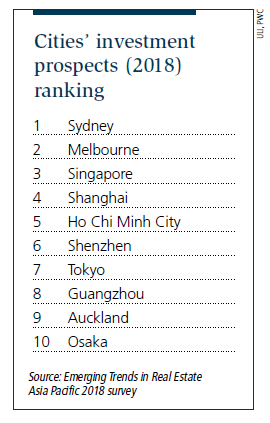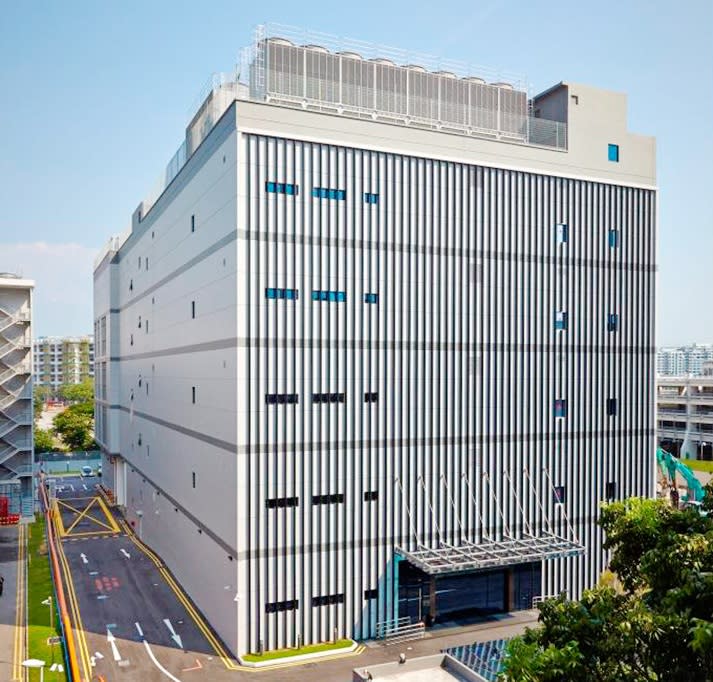Singapore in third place for real estate investment prospects

Singapore’s ranking as an investment market has soared from next-to-bottom last year to third this year, according to the Emerging Trends in Real Estate Asia Pacific 2018 report jointly published by Urban Land Institute (ULI) and PwC.
Singapore’s position is reassuring, given the major projects in the pipeline that will transform the city, such as the development of Jurong Lake District as a second CBD and the doubling of capacities at its air and sea ports, says Khoo Teng Chye, chairman of ULI Singapore.
Investors believe Singapore’s commercial and residential markets are near their bottom, says the report. Office rents have firmed earlier than expected. The residential sector is also showing signs of recovery, with rising transaction volume and the first uptick in prices in four years. Sales of sites have also surged as developers seek to replenish their landbanks. The recovery is likely to be sustainable, owing to several years’ worth of pent-up consumer demand, according to the report.
The investment prospect rankings reflect the growing divergence between the growth- and yield- driven strategies adopted by investors (see table). Cities ranked highest are those in which investors seek to maximise returns through rental growth; look for returns that are safe but still higher than yields on sovereign bonds; or tap secular growth in emerging markets.

“Sydney and Melbourne combine the appeal of a stable investment environment with a combination of relatively good current yields and the prospect of strong rental growth,” says Seek Ngee Huat, ULI Asia- Pacific chairman and chairman of Global Logistic Properties.
The report also identified excess liquidity as the key influencer of the Asia-Pacific investment market for 2018. Increasing capital flows into the region mean more competition for assets, higher prices and lower yields. Fund managers and investors are therefore forced to turn from past dependence on macro-led strategies — which focus on total return or capitalisation rate compression — to asset management for returns. Low base rates and slim yields on sovereign bonds mean that the heat is on for Asia’s capital reserves to shift to higher-yielding assets such as real estate.
In the long term, capital flows from Asian markets are expected to increase, given that they are unable to absorb the sheer volume of funds institutions would like to deploy, notes the report.
Alternative assets
As a result of increased competition for assets, investors are moving into asset classes that did not receive much interest in the past, says the report. In particular, fund managers are looking at data centres, affordable housing, build-to-rent or co-living facilities, and student and senior housing. Investors used to avoid some of these asset classes because of the supposed greater risk or the need for specialised operational expertise.

Data centres, considered too specialised in the past, are now becoming more attractive precisely because their specialised nature keeps out the competition. Investors typically take on such assets in partnership with a seasoned operator. The fragmented nature of Asia’s data centre market also creates scope for merger and acquisition activity. Current undersupply in the region, coupled with the projected increase in future demand, means investors are increasingly looking to Hong Kong, China, India and Singapore for data centre assets, with projected internal rates of return of 13% to 14%.
The affordable housing market is seen as a low- to mid-income proposition because low margins have no appeal to investment funds, according to the report. However, the scope of opportunity is growing as prices of conventional residential properties across Asia-Pacific move beyond the reach of working-class incomes. Government policy initiatives are also beginning to open up the market for large-scale construction.
Investors remain cautious about affordable housing as an asset class as the vast number of new homes will require vast reserves of land, which is seen as a resource that is too hard to find, too expensive or too far from city centres that people would not want to live there.
The long-term rental housing sector has appeal for yield-oriented institutional investors, but “because Asian markets (apart from Japan) have no history of build-to-rent as an asset class, investors are now casting around for a viable business model”, says the report.
Both foreign and domestic investors are actively looking to establish such operating platforms in China, mostly targeting a younger demographic of single or double occupancy. “The demand is huge because the rental class in China is measured in the hundreds of millions,” says a manager of a foreign fund now active in the sector.
The report identifies student housing as another niche area in which Asia-Pacific investors have been active for some time. The focus within the region continues to be on Australia, where international student numbers are booming and inner-city student housing has been an institutional asset class for several years.
Senior housing is one of the sectors that most pique investors’ interest in the region. Regional markets, however, are still fishing around for a suitable business model for the Asian context, says the report. Australia, the most westernised market in the region, has come the closest in coming up with a useable formula.
“There is an opportunity in Australia to build apartment-style upscale accommodation for seniors who are asset-rich but cash-poor, who can downsize and live within their current community with family and friends,” says one Singapore-based fund manager. He is looking into such opportunities, as there is an annual demand in Australia of around 28,000 units in independent living facilities, which is a far cry from the current supply of 8,000 units. The fund he is managing is also looking to partner with established operators on aged-care facilities.

The five-storey Keppel DC Singapore 3 within Tampines Industrial Park. Data centres, considered too specialised in the past, arenow becoming more attractive precisely because their specialised nature keeps out the competition. (Credit: Keppel Land)
This article appeared in EdgeProp Pullout, Issue 807 (Nov 27, 2017).
Related Articles From EdgeProp.sg
Mapletree Investments JV to acquire 14 US data centres at $1.02 bil
Optimism over Cogent’s new bet on student housing
Centurion acquires student housing asset near Yale at $95 mln
Master developers to chart future of Singapore’s urban design

